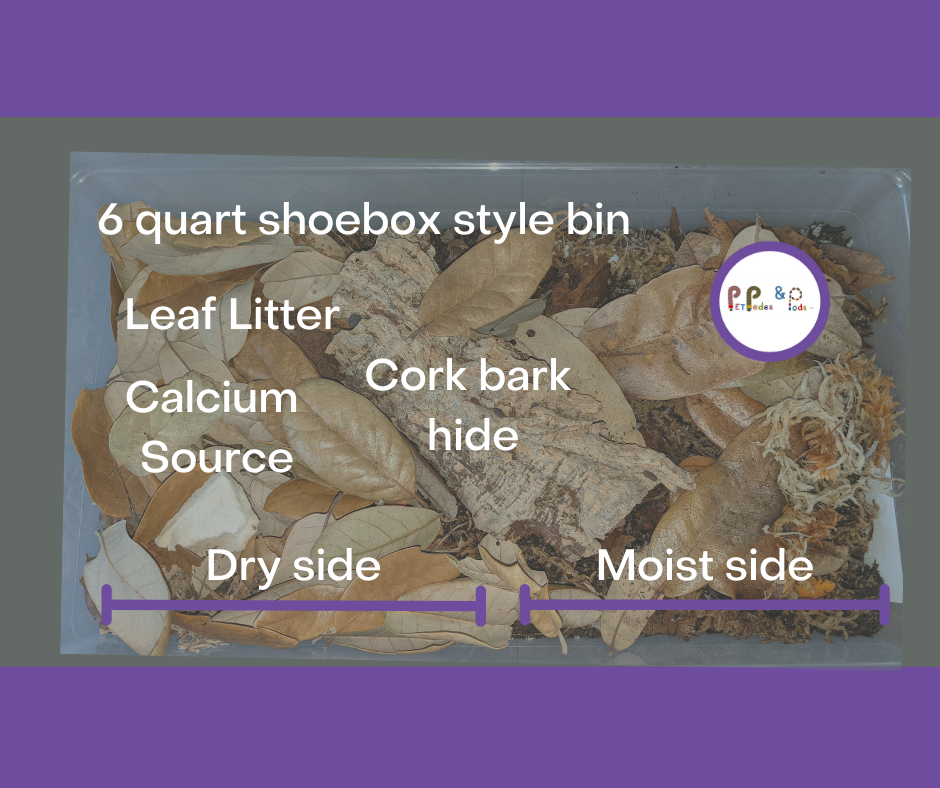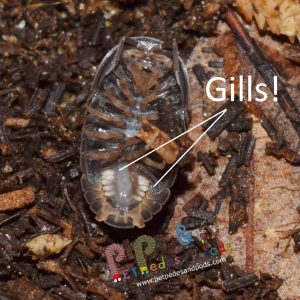Millipede and Isopod General Care Sheet
Please note: this is a general care sheet. Be sure to research your new pet fully! For some species specific notes, click here.
NEVER keep millipedes and isopods together in the same enclosure. Isopods will nibble on millipedes while they are molting, and can damage or even kill them. Isopods will also eat millipede eggs and babies.
Example Isopod Habitat:

Substrate: Use a good quality millipede/isopod substrate such as Lugarti Premium Millipede & Isopod Substrate (which is what we use in house), or make your own. 50% rotting leaves and wood, 50% vivarium substrate or organic compost is a good place to start. Be sure to add plenty of leaf litter and soft rotting wood (if you can easily break it apart with your hands, it’s perfect!). You can collect your own leaves and wood from an area you are certain is free from pesticides. For millipedes: the substrate should provide enough depth for the millipedes to burrow comfortably – generally the substrate should be as deep as the millipede is long. A note on cocofiber/coir: there is some debate about whether this is safe for millipedes. At the very least, it does not provide any nutritional value for the millipedes and there are much better alternatives.
Sterilization: You may want to sterilize any substrate, leaves and wood prior to adding them to your enclosure to avoid introducing mites and other unwanted critters, especially if gathering materials from outside. A good method is to bake in the oven at 200 degrees for at least 30 minutes.
Diet: Millipedes and Isopods are detritivores, meaning they turn waste and rotting leaves and wood into compost. Their main diet should be the rotting leaves and wood in their substrate. Occasionally offer pesticide free fresh fruits and veggies. For Isopods: Isopods require more protein in their diet and should additionally be fed fish food and/or recently dead feeder insects about once a week. Calcium should be provided at all times. Good sources of calcium are cuttlebone, egg shells, or oyster shells. Limestone can be added as an additional calcium component but is not required. Do not use calcium powder as this can actually stick to isopods and dry them out, resulting in death.
Diet for Isopods as Clean Up Crews: If using isopods as a clean up crew, make sure they have leaf litter at all times. As long as you have primary inhabitants creating waste on a regular basis, you should not need to supplement additional food. However, if your primary inhabitant does not poop frequently (snakes, for example) you may need to supplement your clean up crew with protein and calcium sources.
Humidity: Millipedes and Isopods must be kept moist at all times. If they dry out, they will desiccate and die. Isopods actually have gills that they use to breathe with! Monitor your substrate. When the top layer begins to dry out, it’s time to water your enclosure. There is no need to provide a water dish, which in fact can be a drowning hazard. High ventilation is not required and can be detrimental to maintaining humidity levels. If you are using an enclosure with a screen lid, tape some plastic wrap over most of the screen. Most plastic bin enclosures require no additional ventilation, but if you are using one that seals or latches, simply drill a few small holes in the lid for air. For millipedes: all of the substrate should be kept damp, from top to bottom. For isopods: one half of the enclosure should be kept moist and one half should be kept dry, so they can self-regulate. The moist side should be moist through all the layers of substrate – make sure you don’t just mist the top layer. The easiest way to achieve this is to *carefully* water the moist end like you would a potted plant so that the water seeps down through all the substrate on that end – but don’t over saturate your substrate either! Make sure the dry side can stay truly dry.

Temperature: Most millipede and isopod species will thrive at room temperature. If a heat source is required, you can attach an undertank heater to the side of a glass enclosure. Never attach the heater to the bottom of the enclosure. For Bumblebee Millipedes: Bumblebee millipedes require temps of at least 72 degrees.
Molting: Millipedes and Isopods molt, or shed their exoskeleton, periodically as they grow. For Millipedes: Millipedes will completely bury themselves in the substrate to molt. It is very important that you do not disturb them during this vulnerable time. If you do not see your millipede for a long time (even weeks!) do not panic! They are probably molting. Maintain your humidity level and let them do what they need to do. For Isopods: Isopods molt one half of their exoskeleton at a time. Do not mist directly on them when they are in the process of molting.
Handling: Always wash your hands before and after handling your pets. Millipedes sometimes secrete a smelly substance when stressed. This is not irritating to most people, but can stain your skin.
Mites and Mold: both can and will naturally occur and thrive in humid environments, despite your best efforts to sterilize. Mold and fungus are not harmful to your bugs, and they will in fact eat it. Most mites are not harmful, but a large population can stress your pets. Springtails are useful for controlling both mold and mite populations. Mites feed on mold, so the springtails will eliminate the mold and therefore eliminate the mite’s food source.
Species Specific Notes:
Bumblebee Millipedes: While most millipedes are happy at standard home temperatures, Bumblebee millipedes need to be kept at 72 degrees or higher.
Armadillidium klugii “Montenegro” / “Clown” Isopods: The humidity gradient is especially important for this species. They absolutely need to have a totally dry area in addition to a moist area.
Porcellio hoffmannseggi, Porcellio bolivari, Porcellio flavomarginatus, and Porcellio magnificus: These are the “big Spanish isopods.” They all prefer drier environments with high ventilation. They benefit from a larger enclosure with a one moist end and a larger dry side. Usually 1/4 moist and 3/4 dry is a good place to start. The moist side should still be moist all the way through the substrate, and care should be taken to ensure that the moist side does not dry out. Keep in mind that with higher ventilation and a relatively smaller moist area, these enclosures may require more frequent attention than your other isopod enclosures.
Cubaris isopods from Thailand: While different Cubaris isopods may require different care, they all benefit from having a moist half and dry half (though “half” can be adjusted by species as you observe their preferences). Clutter (deep leaf litter, bark/cork bark) is also especially important for them to thrive.
Porcellio and Porcellionides species: the species in these genera are especially protein hungry. Make sure they get plenty of protein provided so they do not cannibalize each other.
Looking for the best isopod to suit your needs? Check out our guide on choosing the right isopod.
Additional Resources:
Amphibicast Episode 37. “The Isopod Episode” with Rachel Schindler of Pet Pedes and Pods
Millipeds In Captivity by Orin A. McMonigle
Questions? Email me! All my bugs are captive bred in my home, and I want to make sure they continue thriving in yours.
NEVER RELEASE YOUR ISOPODS INTO THE ENVIRONMENT. Isopods are regulated by the USDA and can cause a negative environmental impact if released. If you can no longer care for them, you must dispose of these live organisms (and all materials exposed to these organisms) by placing them into plastic bags and freezing them for 3 days before disposal in your regular trash.
